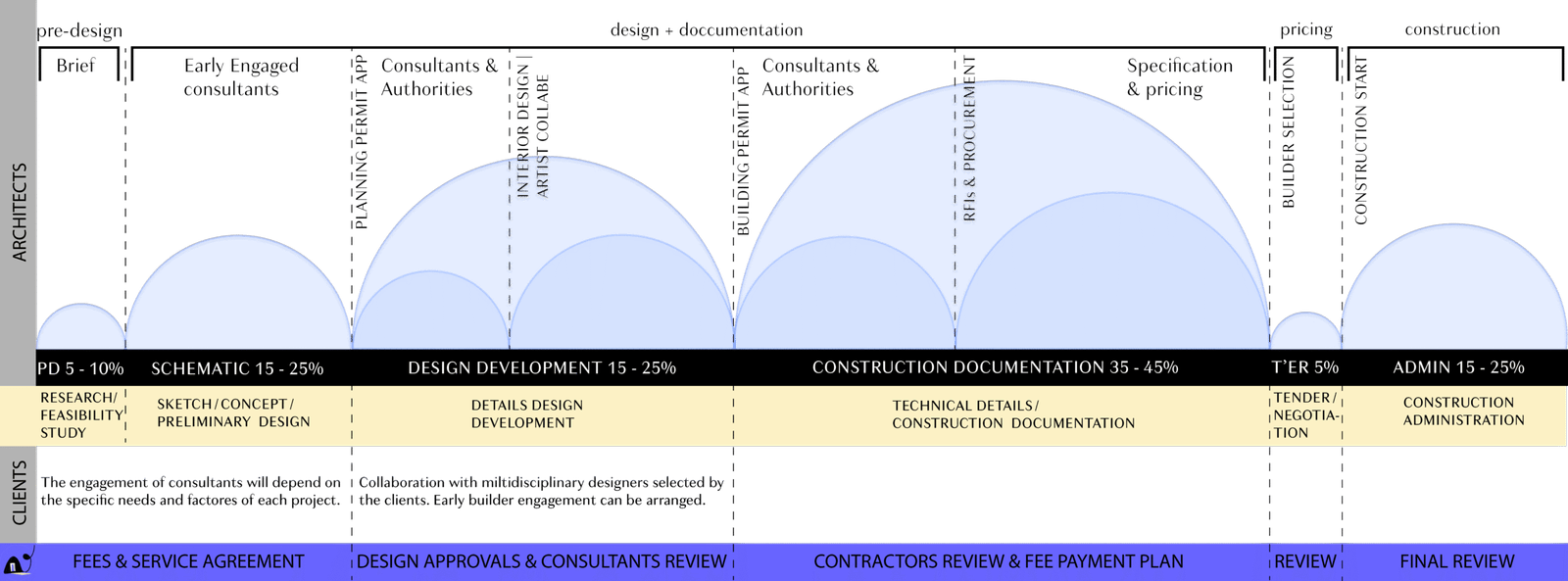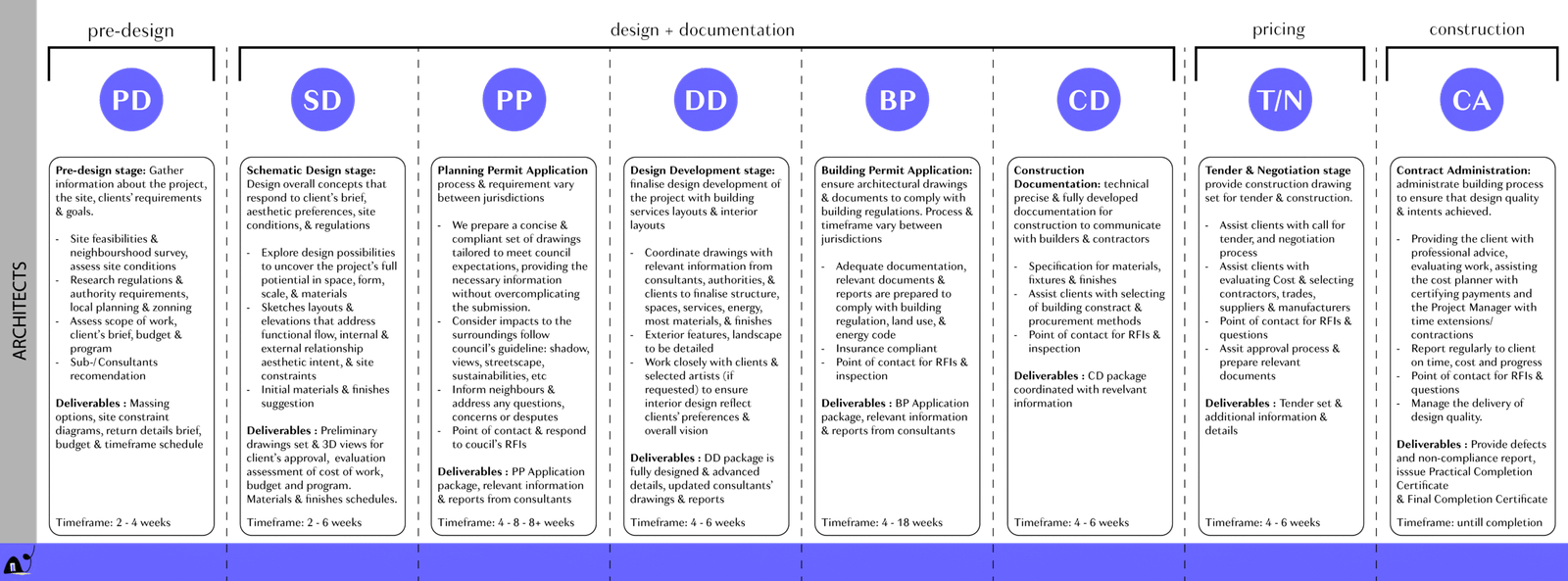Why Us?
We aim to be your partner, not just a service provider
– We commit to delivering designs that are authentic, of quality and beautiful, a place that you will fall in love with!
– Every space is carefully crafted to give clients an advantage – emotionally, functionally, and financially.
– We prioritise service that is responsive, reliable, and transparent
How to work with us?
We understand that sometimes our service does not meet everyone’s needs, and to save you time, we strive to be more efficient. Here is our guideline:
– You have a project/ a brief/ a budget, and want to make your vision come to life!
– Book a complimentary 30-minute initial consultation with us to discuss your goals and determine if our service is the best fit for you.
– Moving forward with a detailed brief and a contract
Learn what we offer and how we tailor our services specifically to your needs.

Project Phases Diagram
Project Phases: Stages of the design and approval process guideline
Our project phases are illustrated in the diagram above, which often includes Schematic Design, Design Development, Construction Documentation, and Administration. After an initial meeting with clients, we will customise and choose a specific service to match each project’s needs adequately. Below is a detailed summary of what to expect during each stage of the design and approval process guideline for a full-service.
Select & Engage an Architect
- This involves approaching and meeting with an architect on site to discuss the brief / budget and timeframes and then selecting an architect appropriate for your project.
- A reasonable time to allow for this is 2-3 weeks.
Pre-design: Feasibility study & developing the brief / budget:
- This is where the brief is tested against site suitability, council regulations, budget and other criteria. Many projects, when they are initially conceived, are simply unworkable for one reason or another & will need to be refined. Two common problems are an inadequate budget or issues to do with local building controls. This is also the stage in which your borrowing capacity or financial constraints need to be resolved.
- Time to allow: 1-3 weeks.
Schematic Design
- This is where your architect begins the creative and skilled process of designing your home or home improvements. The key aim here is to create an overall concept of the building in terms of size & configuration, location on the site, views, sunlight & style or aesthetics. Other factors such as construction materials, finishes & colours are also often suggested.
- Time to allow: 2-4 weeks.
Schematic Design Review
- This is where the brief is tested against site suitability, council regulations, budget and other criteria. Many projects, when they are initially conceived, are simply unworkable for one reason or another & will need to be refined. Two common problems are an inadequate budget or issues to do with local building controls. This is also the stage in which your borrowing capacity or financial constraints need to be resolved.
- Time to allow: 1-3 weeks.
Planning Permit Application
Watching your hard work come to life typically takes 12-24 months but can take longer, depending on the project’s size, complexity, and location. Your general contractor is responsible for the schedule and timeline of your project. Once the project is underway, we stay involved throughout the construction process to answer questions, help troubleshoot, and ensure your vision is followed until you move in.
Design Development
- This is where the concept design is further developed and preliminary council approval documents are produced. These documents are called ‘General Arrangement Drawings’ and are usually prepared at 1:100 scale. These drawings show: the existing building and proposed work; accurate site levels (prepared by a surveyor) and the council’s building envelope. They allow for the required floor areas and other measures to be calculated accurately for council and provide a basis for discussions with neighbours. This step also generally involves a more detailed costing (prepared by a quantity surveyor or a builder / building cost estimator) and a preliminary DA meeting with council.
- Time to allow: 3-5 weeks.
Design Development review
- This review is almost the final review before submitting your application to council. At this point in the process, only small changes should be considered, if any. The focus should be on strategies for achieving development approval as quickly and easily as possible.
- Time to allow: 1-2 weeks.
Building Permit Application | Completing development approval documents:
- Generally, councils require a lot of additional information to be submitted in addition to the drawings as part of the development application process, including reports and other work done by consultants. Assessments required may include that pertaining to bushfire, heritage & conservation, geotechnics, stormwater, waste & recycling, sediment & erosion control, flora & fauna, an arborist report (trees), energy ratings, BASIX reports & shadow and solar access diagrams.
- Time to allow: 4-6 weeks.
Construction Documents
Construction Documents are the final deliverable you receive from us before construction. We add another layer of information by documenting and specifying the selections made during the preceding phases. This phase culminates with two distinct drawing sets: a Building Department review set for permits and a Construction set for the General Contractor, with added specifications and detail to provide final construction costs.
Building Department Review Set:
A drawing set is developed explicitly for the building department review process and has only the necessary information to demonstrate development and building code compliance. This method ensures a faster review schedule so you can begin construction sooner.
Construction Set:
We continue adding details and specifications to the building department review set during the permit review process. Once our work is complete, the builder can provide final construction costs simultaneously with building permit issuance. That ensures you’re ready to begin construction with minimal downtime.
Tender | Negotiation | Engaing Builder
The time involved in this process depends largely on your choice of tenderers and the contents of their tenders. It is a good idea not to be in a hurry to sign up a builder as it reduces your bargaining power.
Time to allow: 2-4 weeks.
Construction Adminstration
While most of the architect’s work is done before any building begins, our consistent presence during the construction phase is equally important. During this phase we visit the jobsite at regular intervals to answer questions from the builder and proactively address potential issues. The frequency of our site visits could be weekly or monthly depending on the project and your needs, but it is vital to have us keeping an eye on things to ensure the finished project meets your expectations. Inevitably, some decisions must be made or modified in the field, and our involvement and ability to work quickly with your contractor to solve problems is essential for helping you avoid costly delays and change orders. During Construction Administration, the architect’s role is advisor to the owner. At our site visits we will take photos and write field reports to document the progress, confirm the materials and workmanship are of the quality you agreed to, and verify your contractor’s billings accurately reflect the amount of work completed. At the end of the project, we help you develop your final Punch List to ensure all work is completed to your satisfaction.

Project Phases Diagram
EXPERTISE
Building a home is a significant undertaking, and we have the expertise to assist you.
Coastal Properties
Coastal Development has a unique discretionary process, whether governed by a Local Coastal Program or the California Coastal Commission. Our past work has included bluff-top new builds and an inland watershed project.
Vacant Undeveloped Land
County or city, vacant property development has added planning requirements. From Santa Cruz to San Diego, our planning and design work has resulted in one-of-a-kind custom homes.
Urban Infill
Urban infill development is influenced by its context. With current City and State incentives, much more can be developed than previously possible. As these regulations are in flux, we aim to stay up-to-date so you don’t have to.
Challenging Properties
Challenging Properties can often be developed to create dramatic architecture. We can discuss potential processes, time, and cost increases associated with building on challenging lots.
Fire Rebuilds
This is perhaps our most challenging service offering because there isn’t a standard redevelopment process. Each municipality has its own way of managing rebuilding after a fire. The bottom line is to be proactive in building a more resilient house so there is a greater chance of survival during the next fire.
Hillside Homes
Here is an opportunity to create lasting architecture sensitive to its location.
Midcentury Modern Homes
The optimism of post-war architecture has seen a resurgence since the beginning of the 21st century. We have helped many enthusiasts re-energize these houses by renovating or adding to them while maintaining the MCM spirit. Our expertise has been applied to buildings initially designed by acclaimed midcentury architects, including Homer Delawie, Robert Mosher, William Krisel (Palmer & Krisel), and Cliff May.
Transformation
Sometimes you’re not sure what is wrong, but you know you need a change. Reimagining your home for today’s lifestyle is in our wheelhouse.
Deep Energy Retrofit
Older houses – especially Midcentury Moderns – are energy inefficient, and we help solve that issue through different tiers of energy efficiency strategies. Besides becoming comfortable to live in, these additions will save you energy.
Discovery Service: Pre-Development Analysis
Are you seeking an expert opinion about a property you’re considering? Or are you struggling to decide between several properties that could meet your needs? This initial phase is to help you make quick decisions before investing in a property. Our pre-development analysis service, backed by years of experience and a deep understanding of the market, allows you to make informed decisions.
Process & Timeline
Research, Documentation, & Analysis: 2-6 weeks
Pre-design Phase
-We help you compare properties if you haven’t decided on a specific one yet.
-We meet on the site to get to know you and discuss your goals.
-We research regulations to understand the development parameters.
-We identify and coordinate consultants needed during this phase.
-We analyze the data to define your development options.
New Build Home
This service focuses on the design of a completely new home, regardless of whether it is a vacant lot or has an existing house that doesn’t suit your needs. You will benefit from our vision of building placement and orientation, as well as site amenities, including landscape, responsive architectural forms, and resilient interior fit and finish. Services are tailored to your needs, including sustainability, specialty lighting, and interior design.
Process & Timeline
Design and Documentation: 4-12 months
Pre-design Phase
-We identify development regulations, study the property, and develop a game plan.
Schematic Design Phase
-We create concept designs, refine the design based on your feedback, and provide general opinions on cost. The big picture is now in sight.
Design Development Phase
-We add detail, begin the product selection process, hire consultants for selected work, and continue the construction cost analysis.
Construction Document Phase
-We document selections and details, coordinate consultants, and prepare plans for building permit submittal and final construction costs.
Building Permit Phase
-We streamline the permit process by keeping it in-house.
Construction Phase
-We assist the general contractor through the construction process so your vision is realized with minimal effort.
Read more about our Typical Project Phases below.
Addition/Renovation
We transform homes. You live in a great neighborhood and love your home. Perhaps you raised your children there and have fond memories, but now it no longer suits your needs. Or it feels dated, and you’re ready for change. We take a fresh look into your home’s future and bring new life to memories ahead. The process is similar to a new build, with a difference summarized below.
Process & Timeline
Existing Conditions Survey: 2-4 weeks, included within the Design and Documentation schedule.
-We bring a team to laser scan and convert your existing home into a 3-dimensional model to create drawings of existing conditions. The service includes a web-based dollhouse application that reduces the need to revisit the site to answer additional questions.
